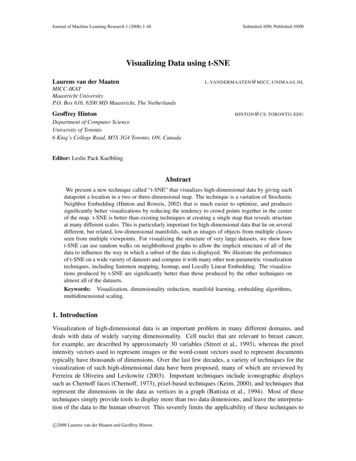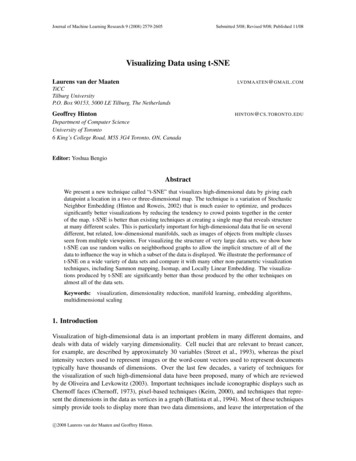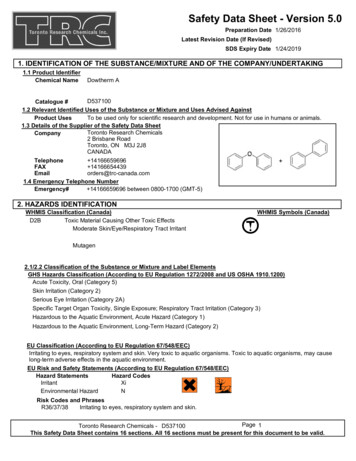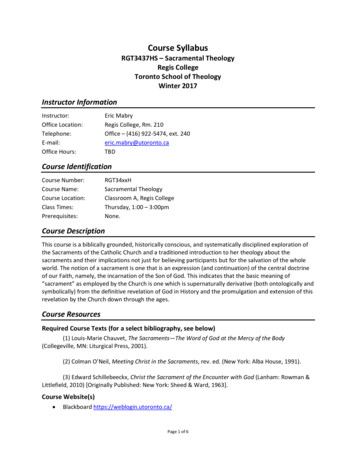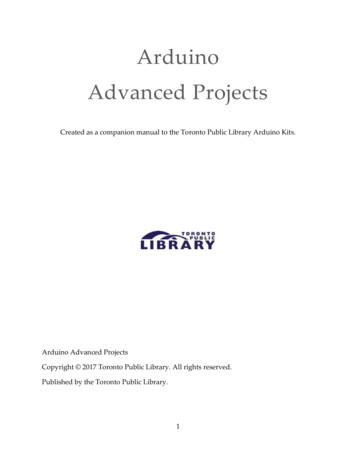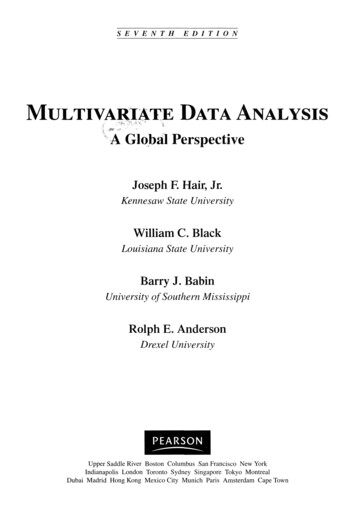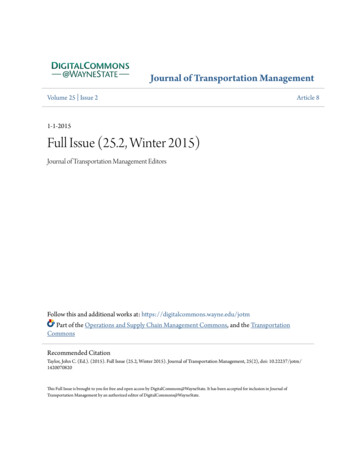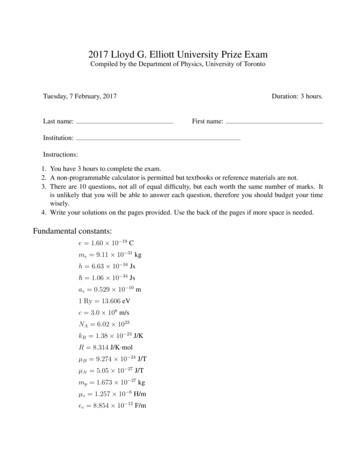
Transcription
Probability and StatisticsThe Science of UncertaintySecond EditionMichael J. Evans and Je rey S. RosenthalUniversity of Toronto
ContentsPrefaceix1 Probability Models1.1 Probability: A Measure of Uncertainty . . . . .1.1.1 Why Do We Need Probability Theory?1.2 Probability Models . . . . . . . . . . . . . . .1.2.1 Venn Diagrams and Subsets . . . . . .1.3 Properties of Probability Models . . . . . . . .1.4 Uniform Probability on Finite Spaces . . . . .1.4.1 Combinatorial Principles . . . . . . . .1.5 Conditional Probability and Independence . . .1.5.1 Conditional Probability . . . . . . . . .1.5.2 Independence of Events . . . . . . . .1.6 Continuity of P . . . . . . . . . . . . . . . . .1.7 Further Proofs (Advanced) . . . . . . . . . . .1124710141520202328312 Random Variables and Distributions2.1 Random Variables . . . . . . . . . . . . . . . . . . . . . . . . . .2.2 Distributions of Random Variables . . . . . . . . . . . . . . . . .2.3 Discrete Distributions . . . . . . . . . . . . . . . . . . . . . . . .2.3.1 Important Discrete Distributions . . . . . . . . . . . . . .2.4 Continuous Distributions . . . . . . . . . . . . . . . . . . . . . .2.4.1 Important Absolutely Continuous Distributions . . . . . .2.5 Cumulative Distribution Functions . . . . . . . . . . . . . . . . .2.5.1 Properties of Distribution Functions . . . . . . . . . . . .2.5.2 Cdfs of Discrete Distributions . . . . . . . . . . . . . . .2.5.3 Cdfs of Absolutely Continuous Distributions . . . . . . .2.5.4 Mixture Distributions . . . . . . . . . . . . . . . . . . . .2.5.5 Distributions Neither Discrete Nor Continuous (Advanced)2.6 One-Dimensional Change of Variable . . . . . . . . . . . . . . .2.6.1 The Discrete Case . . . . . . . . . . . . . . . . . . . . .2.6.2 The Continuous Case . . . . . . . . . . . . . . . . . . . .2.7 Joint Distributions . . . . . . . . . . . . . . . . . . . . . . . . . .2.7.1 Joint Cumulative Distribution Functions . . . . . . . . . .333438414251536263646568707475757980iii.
ivCONTENTS2.7.2 Marginal Distributions . . . . . . . . . . . . .2.7.3 Joint Probability Functions . . . . . . . . . . .2.7.4 Joint Density Functions . . . . . . . . . . . .2.8 Conditioning and Independence . . . . . . . . . . . .2.8.1 Conditioning on Discrete Random Variables . .2.8.2 Conditioning on Continuous Random Variables2.8.3 Independence of Random Variables . . . . . .2.8.4 Order Statistics . . . . . . . . . . . . . . . . .2.9 Multidimensional Change of Variable . . . . . . . . .2.9.1 The Discrete Case . . . . . . . . . . . . . . .2.9.2 The Continuous Case (Advanced) . . . . . . .2.9.3 Convolution . . . . . . . . . . . . . . . . . . .2.10 Simulating Probability Distributions . . . . . . . . . .2.10.1 Simulating Discrete Distributions . . . . . . .2.10.2 Simulating Continuous Distributions . . . . . .2.11 Further Proofs (Advanced) . . . . . . . . . . . . . . 411491621691731731761771791841871911944 Sampling Distributions and Limits4.1 Sampling Distributions . . . . . . . . . . . . . . . . . .4.2 Convergence in Probability . . . . . . . . . . . . . . . .4.2.1 The Weak Law of Large Numbers . . . . . . . .4.3 Convergence with Probability 1 . . . . . . . . . . . . . .4.3.1 The Strong Law of Large Numbers . . . . . . .4.4 Convergence in Distribution . . . . . . . . . . . . . . .4.4.1 The Central Limit Theorem . . . . . . . . . . .4.4.2 The Central Limit Theorem and Assessing Error4.5 Monte Carlo Approximations . . . . . . . . . . . . . . .4.6 Normal Distribution Theory . . . . . . . . . . . . . . .4.6.1 The Chi-Squared Distribution . . . . . . . . . .4.6.2 The t Distribution . . . . . . . . . . . . . . . . .1992002032052082112132152202242342362393 Expectation3.1 The Discrete Case . . . . . . . . . . . . . . .3.2 The Absolutely Continuous Case . . . . . . .3.3 Variance, Covariance, and Correlation . . . .3.4 Generating Functions . . . . . . . . . . . . .3.4.1 Characteristic Functions (Advanced) .3.5 Conditional Expectation . . . . . . . . . . .3.5.1 Discrete Case . . . . . . . . . . . . .3.5.2 Absolutely Continuous Case . . . . .3.5.3 Double Expectations . . . . . . . . .3.5.4 Conditional Variance (Advanced) . .3.6 Inequalities . . . . . . . . . . . . . . . . . .3.6.1 Jensen’s Inequality (Advanced) . . .3.7 General Expectations (Advanced) . . . . . .3.8 Further Proofs (Advanced) . . . . . . . . . .
CONTENTS4.7v4.6.3 The F Distribution . . . . . . . . . . . . . . . . . . . . . . . 240Further Proofs (Advanced) . . . . . . . . . . . . . . . . . . . . . . . 2465 Statistical Inference5.1 Why Do We Need Statistics? . . . .5.2 Inference Using a Probability Model5.3 Statistical Models . . . . . . . . . .5.4 Data Collection . . . . . . . . . . .5.4.1 Finite Populations . . . . .5.4.2 Simple Random Sampling .5.4.3 Histograms . . . . . . . . .5.4.4 Survey Sampling . . . . . .5.5 Some Basic Inferences . . . . . . .5.5.1 Descriptive Statistics . . . .5.5.2 Plotting Data . . . . . . . .5.5.3 Types of Inference . . . . .2532542582622692702712742762822822872896 Likelihood Inference6.1 The Likelihood Function . . . . . . . . . . . . . . . . .6.1.1 Sufficient Statistics . . . . . . . . . . . . . . . .6.2 Maximum Likelihood Estimation . . . . . . . . . . . . .6.2.1 Computation of the MLE . . . . . . . . . . . . .6.2.2 The Multidimensional Case (Advanced) . . . . .6.3 Inferences Based on the MLE . . . . . . . . . . . . . . .6.3.1 Standard Errors, Bias, and Consistency . . . . .6.3.2 Confidence Intervals . . . . . . . . . . . . . . .6.3.3 Testing Hypotheses and P-Values . . . . . . . .6.3.4 Inferences for the Variance . . . . . . . . . . . .6.3.5 Sample-Size Calculations: Confidence Intervals .6.3.6 Sample-Size Calculations: Power . . . . . . . .6.4 Distribution-Free Methods . . . . . . . . . . . . . . . .6.4.1 Method of Moments . . . . . . . . . . . . . . .6.4.2 Bootstrapping . . . . . . . . . . . . . . . . . . .6.4.3 The Sign Statistic and Inferences about Quantiles6.5 Large Sample Behavior of the MLE (Advanced) . . . . 573647 Bayesian Inference7.1 The Prior and Posterior Distributions . . . . . .7.2 Inferences Based on the Posterior . . . . . . . .7.2.1 Estimation . . . . . . . . . . . . . . .7.2.2 Credible Intervals . . . . . . . . . . . .7.2.3 Hypothesis Testing and Bayes Factors .7.2.4 Prediction . . . . . . . . . . . . . . . .7.3 Bayesian Computations . . . . . . . . . . . . .7.3.1 Asymptotic Normality of the Posterior .7.3.2 Sampling from the Posterior . . . . . .373374384387391394400407407407.
viCONTENTS7.3.37.47.5Sampling from the Posterior Using Gibbs Sampling(Advanced) . . . . . . . . . . . . . . . . . . . . . . . . . . .Choosing Priors . . . . . . . . . . . . . . . . . . . . . . . . . . . . .7.4.1 Conjugate Priors . . . . . . . . . . . . . . . . . . . . . . . .7.4.2 Elicitation . . . . . . . . . . . . . . . . . . . . . . . . . . . .7.4.3 Empirical Bayes . . . . . . . . . . . . . . . . . . . . . . . .7.4.4 Hierarchical Bayes . . . . . . . . . . . . . . . . . . . . . . .7.4.5 Improper Priors and Noninformativity . . . . . . . . . . . . .Further Proofs (Advanced) . . . . . . . . . . . . . . . . . . . . . . .7.5.1 Derivation of the Posterior Distribution for the Location-ScaleNormal Model . . . . . . . . . . . . . . . . . . . . . . . . .7.5.2 Derivation of J (θ(ψ 0 , λ)) for the Location-Scale Normal . .4134214224224234244254304304318 Optimal Inferences8.1 Optimal Unbiased Estimation . . . . . . . . . . . . . . . . . . .8.1.1 The Rao–Blackwell Theorem and Rao–Blackwellization8.1.2 Completeness and the Lehmann–Scheffé Theorem . . .8.1.3 The Cramer–Rao Inequality (Advanced) . . . . . . . . .8.2 Optimal Hypothesis Testing . . . . . . . . . . . . . . . . . . .8.2.1 The Power Function of a Test . . . . . . . . . . . . . .8.2.2 Type I and Type II Errors . . . . . . . . . . . . . . . . .8.2.3 Rejection Regions and Test Functions . . . . . . . . . .8.2.4 The Neyman–Pearson Theorem . . . . . . . . . . . . .8.2.5 Likelihood Ratio Tests (Advanced) . . . . . . . . . . .8.3 Optimal Bayesian Inferences . . . . . . . . . . . . . . . . . . .8.4 Decision Theory (Advanced) . . . . . . . . . . . . . . . . . . .8.5 Further Proofs (Advanced) . . . . . . . . . . . . . . . . . . . .4334344354384404464464474484494554604644739 Model Checking9.1 Checking the Sampling Model . . . . . . . . .9.1.1 Residual and Probability Plots . . . . .9.1.2 The Chi-Squared Goodness of Fit Test .9.1.3 Prediction and Cross-Validation . . . .9.1.4 What Do We Do When a Model Fails? .9.2 Checking for Prior–Data Conflict . . . . . . . .9.3 The Problem with Multiple Checks . . . . . . .47947948649149549650250910 Relationships Among Variables10.1 Related Variables . . . . . . . . . . . . . . . . . . .10.1.1 The Definition of Relationship . . . . . . . .10.1.2 Cause–Effect Relationships and Experiments10.1.3 Design of Experiments . . . . . . . . . . . .10.2 Categorical Response and Predictors . . . . . . . . .10.2.1 Random Predictor . . . . . . . . . . . . . .10.2.2 Deterministic Predictor . . . . . . . . . . . .10.2.3 Bayesian Formulation . . . . . . . . . . . .511512512516519527527530533.
CONTENTSvii10.3 Quantitative Response and Predictors . . . . . . . . . . .10.3.1 The Method of Least Squares . . . . . . . . . . .10.3.2 The Simple Linear Regression Model . . . . . . .10.3.3 Bayesian Simple Linear Model (Advanced) . . . .10.3.4 The Multiple Linear Regression Model (Advanced)10.4 Quantitative Response and Categorical Predictors . . . . .10.4.1 One Categorical Predictor (One-Way ANOVA) . .10.4.2 Repeated Measures (Paired Comparisons) . . . . .10.4.3 Two Categorical Predictors (Two-Way ANOVA) .10.4.4 Randomized Blocks . . . . . . . . . . . . . . . .10.4.5 One Categorical and One Quantitative Predictor . .10.5 Categorical Response and Quantitative Predictors . . . . .10.6 Further Proofs (Advanced) . . . . . . . . . . . . . . . . .11 Advanced Topic — Stochastic Processes11.1 Simple Random Walk . . . . . . . . . . . .11.1.1 The Distribution of the Fortune . .11.1.2 The Gambler’s Ruin Problem . . .11.2 Markov Chains . . . . . . . . . . . . . . .11.2.1 Examples of Markov Chains . . . .11.2.2 Computing with Markov Chains . .11.2.3 Stationary Distributions . . . . . .11.2.4 Markov Chain Limit Theorem . . .11.3 Markov Chain Monte Carlo . . . . . . . .11.3.1 The Metropolis–Hastings Algorithm11.3.2 The Gibbs Sampler . . . . . . . . .11.4 Martingales . . . . . . . . . . . . . . . . .11.4.1 Definition of a Martingale . . . . .11.4.2 Expected Values . . . . . . . . . .11.4.3 Stopping Times . . . . . . . . . . .11.5 Brownian Motion . . . . . . . . . . . . . .11.5.1 Faster and Faster Random Walks . .11.5.2 Brownian Motion as a Limit . . . .11.5.3 Diffusions and Stock Prices . . . .11.6 Poisson Processes . . . . . . . . . . . . . .11.7 Further Proofs . . . . . . . . . . . . . . . 1665668AppendicesA Mathematical BackgroundA.1 Derivatives . . . . . .A.2 Integrals . . . . . . . .A.3 Infinite Series . . . . .A.4 Matrix Multiplication .A.5 Partial Derivatives . . .675.675675676677678678
viiiCONTENTSA.6 Multivariable Integrals . . . . . . . . . . . . . . . . . . . . . . . . . 679B Computations683B.1 Using R . . . . . . . . . . . . . . . . . . . . . . . . . . . . . . . . . 683B.2 Using Minitab . . . . . . . . . . . . . . . . . . . . . . . . . . . . . . 699C Common Distributions705C.1 Discrete Distributions . . . . . . . . . . . . . . . . . . . . . . . . . . 705C.2 Absolutely Continuous Distributions . . . . . . . . . . . . . . . . . . 706D TablesD.1 Random Numbers . . . . . . . . . .D.2 Standard Normal Cdf . . . . . . . .D.3 Chi-Squared Distribution QuantilesD.4 t Distribution Quantiles . . . . . . .D.5 F Distribution Quantiles . . . . . .D.6 Binomial Distribution Probabilities .E Answers to Odd-Numbered ExercisesIndex.709710712713714715724729750
PrefaceThis book is an introductory text on probability and statistics, targeting students whohave studied one year of calculus at the university level and are seeking an introductionto probability and statistics with mathematical content. Where possible, we providemathematical details, and it is expected that students are seeking to gain some masteryover these, as well as to learn how to conduct data analyses. All the usual methodologies covered in a typical introductory course are introduced, as well as some of thetheory that serves as their justification.The text can be used with or without a statistical computer package. It is our opinion that students should see the importance of various computational techniques inapplications, and the book attempts to do this. Accordingly, we feel that computationalaspects of the subject, such as Monte Carlo, should be covered, even if a statisticalpackage is not used. Almost any statistical package is suitable. A Computationsappendix provides an introduction to the R language. This covers all aspects of thelanguage needed to do the computations in the text. Furthermore, we have providedthe R code for any of the more complicated computations. Students can use theseexamples as templates for problems that involve such computations, for example, using Gibbs sampling. Also, we have provided, in a separate section of this appendix,Minitab code for those computations that are slightly involved, e.g., Gibbs sampling.No programming experience is required of students to do the problems.We have organized the exercises in the book into groups, as an aid to users. Exercises are suitable for all students and offer practice in applying the concepts discussedin a particular section. Problems require greater understanding, and a student can expect to spend more thinking time on these. If a problem is marked (MV), then it willrequire some facility with multivariable calculus beyond the first calculus course, although these problems are not necessarily hard. Challenges are problems that moststudents will find difficult; these are only for students who have no trouble with theExercises and the Problems. There are also Computer Exercises and ComputerProblems, where it is expected that students will make use of a statistical package inderiving solutions.We have included a number of Discussion Topics designed to promote criticalthinking in students. Throughout the book, we try to point students beyond the masteryof technicalities to think of the subject in a larger frame of reference. It is important thatstudents acquire a sound mathematical foundation in the basic techniques of probabilityand statistics, which we believe this book will help students accomplish. Ultimately,however, these subjects are applied in real-world contexts, so it is equally importantthat students understand how to go about their application and understand what issuesarise. Often, there are no right answers to Discussion Topics; their purpose is to get a
xPrefacestudent thinking about the subject matter. If these were to be used for evaluation, thenthey would be answered in essay format and graded on the maturity the student showedwith respect to the issues involved. Discussion Topics are probably most suitable forsmaller classes, but these will also benefit students who simply read them over andcontemplate their relevance.Some sections of the book are labelled Advanced. This material is aimed at students who are more mathematically mature (for example, they are taking, or have taken,a second course in calculus). All the Advanced material can be skipped, with no lossof continuity, by an instructor who wishes to do so. In particular, the final chapter of thetext is labelled Advanced and would only be taught in a high-level introductory courseaimed at specialists. Also, many proofs appear in the final section of many chapters,labelled Further Proofs (Advanced). An instructor can choose which (if any) of theseproofs they wish to present to their students.As such, we feel that the material in the text is presented in a flexible way thatallows the instructor to find an appropriate level for the students they are teaching. AMathematical Background appendix reviews some mathematical concepts, from afirst course in calculus, in case students could use a refresher, as well as brief introductions to partial derivatives, double integrals, etc.Chapter 1 introduces the probability model and provides motivation for the studyof probability. The basic properties of a probability measure are developed.Chapter 2 deals with discrete, continuous, joint distributions, and the effects ofa change of variable. It also introduces the topic of simulating from a probabilitydistribution. The multivariate change of variable is developed in an Advanced section.Chapter 3 introduces expectation. The probability-generating function is discussed, as are the moments and the moment-generating function of a random variable.This chapter develops some of the major inequalities used in probability. A section oncharacteristic functions is included as an Advanced topic.Chapter 4 deals with sampling distributions and limits. Convergence in probability, convergence with probability 1, the weak and strong laws of large numbers, convergence in distribution, and the central limit theorem are all introduced, along withvarious applications such as Monte Carlo. The normal distribution theory, necessaryfor many statistical applications, is also dealt with here.As mentioned, Chapters 1 through 4 include material on Monte Carlo techniques.Simulation is a key aspect of the application of probability theory, and it is our viewthat its teaching should be integrated with the theory right from the start. This revealsthe power of probability to solve real-world problems and helps convince students thatit is far more than just an interesting mathematical theory. No practitioner divorceshimself from the theory when using the computer for computations or vice versa. Webelieve this is a more modern way of teaching the subject. This material can be skipped,however, if an instructor believes otherwise or feels there is not enough time to coverit effectively.Chapter 5 is an introduction to statistical inference. For the most part, this is concerned with laying the groundwork for the development of more formal methodologyin later chapters. So practical issues — such as proper data collection, presenting datavia graphical techniques, and informal inference methods like descriptive statistics —are discussed here.
PrefacexiChapter 6 deals with many of the standard methods of inference for one-sampleproblems. The theoretical justification for these methods is developed primarily throughthe likelihood function, but the treatment is still fairly informal. Basic methods of inference, such as the standard error of an estimate, confidence intervals, and P-values,are introduced. There is also a section devoted to distribution-free (nonparametric)methods like the bootstrap.Chapter 7 involves many of the same problems discussed in Chapter 6, but nowfrom a Bayesian perspective. The point of view adopted here is not that Bayesian methods are better or, for that matter, worse than those of Chapter 6. Rather, we take theview that Bayesian methods arise naturally when the statistician adds another ingredient — the prior — to the model. The appropriateness of this, or the sampling modelfor the data, is resolved through the model-checking methods of Chapter 9. It is notour intention to have students adopt a particular philosophy. Rather, the text introducesstudents to a broad spectrum of statistical thinking.Subsequent chapters deal with both frequentist and Bayesian approaches to thevarious problems discussed. The Bayesian material is in clearly labelled sections andcan be skipped with no loss of continuity, if so desired. It has become apparent inrecent years, however, that Bayesian methodology is widely used in applications. Assuch, we feel that it is important for students to be exposed to this, as well as to thefrequentist approaches, early in their statistical education.Chapter 8 deals with the traditional optimality justifications offered for some statistical inferences. In particular, some aspects of optimal unbiased estimation and theNeyman–Pearson theorem are discussed. There is also a brief introduction to decisiontheory. This chapter is more formal and mathematical than Chapters 5, 6, and 7, and itcan be skipped, with no loss of continuity, if an instructor wants to emphasize methodsand applications.Chapter 9 is on model checking. We placed model checking in a separate chapterto emphasize its importance in applications. In practice, model checking is the waystatisticians justify the choices they make in selecting the ingredients of a statisticalproblem. While these choices are inherently subjective, the methods of this chapterprovide checks to make sure that the choices made are sensible in light of the objectiveobserved data.Chapter 10 is concerned with the statistical analysis of relationships among variables. This includes material on simple linear and multiple regression, ANOVA, thedesign of experiments, and contingency tables. The emphasis in this chapter is onapplications.Chapter 11 is concerned with stochastic processes. In particular, Markov chainsand Markov chain Monte Carlo are covered in this chapter, as are Brownian motion andits relevance to finance. Fairly sophisticated topics are introduced, but the treatment isentirely elementary. Chapter 11 depends only on the material in Chapters 1 through 4.A one-semester course on probability would cover Chapters 1–4 and perhaps someof Chapter 11. A one-semester, follow-up course on statistics would cover Chapters 5–7 and 9–10. Chapter 8 is not necessary, but some parts, such as the theory of unbiasedestimation and optimal testing, are suitable for a more theoretical course.A basic two-semester course in probability and statistics would cover Chapters 1–6and 9–10. Such a course covers all the traditional topics, including basic probability
xiiPrefacetheory, basic statistical inference concepts, and the usual introductory applied statisticstopics. To cover the entire book would take three semesters, which could be organizedin a variety of ways.The Advanced sections can be skipped or included, depending on the level of thestudents, with no loss of continuity. A similar approach applies to Chapters 7, 8, and11.Students who have already taken an introductory, noncalculus-based, applied statistics course will also benefit from a course based on this text. While similar topics arecovered, they are presented with more depth and rigor here. For example, Introductionto the Practice of Statistics, 6th ed., by D. Moore and G. McCabe (W. H. Freeman,2009) is an excellent text, and we believe that our book would serve as a strong basisfor a follow-up course.There is an Instructor’s Solutions Manual available from the publisher.The second edition contains many more basic exercises than the first edition. Also,we have rewritten a number of sections, with the aim of making the material clearer tostudents. One goal in our rewriting was to subdivide the material into smaller, moredigestible components so that key ideas stand out more boldly. There has been a complete typographical redesign that we feel aids in this as well. In the appendices, we haveadded material on the statistical package R as well as answers for the odd-numberedexercises that students can use to check their understanding.Many thanks to the reviewers and users for their comments: Abbas Alhakim (Clarkson University), Michelle Baillargeon (McMaster University), Arne C. Bathke (University of Kentucky), Lisa A. Bloomer (Middle Tennessee State University), ChristopherBrown (California Lutheran University), Jem N. Corcoran (University of Colorado),Guang Cheng (Purdue University), Yi Cheng (Indiana University South Bend), EugeneDemidenko (Dartmouth College), Robert P. Dobrow (Carleton College), John Ferdinands (Calvin College), Soledad A. Fernandez (The Ohio State University), ParamjitGill (University of British Columbia Okanagan), Marvin Glover (Milligan College),Ellen Gundlach (Purdue University), Paul Gustafson (University of British Columbia),Jan Hannig (Colorado State University), Solomon W. Harrar (The University of Montana), Susan Herring (Sonoma State University), George F. Hilton (Pacific Union College), Chun Jin (Central Connecticut State University), Paul Joyce (University of Idaho),Hubert Lilliefors (George Washington University), Andy R. Magid (University of Oklahoma), Phil McDonnough (University of Toronto), Julia Morton (Nipissing University), Jean D. Opsomer (Colorado State University), Randall H. Rieger (West ChesterUniversity), Robert L. Schaefer (Miami University), Osnat Stramer (University ofIowa), Tim B. Swartz (Simon Fraser University), Glen Takahara (Queen’s University),Robert D. Thompson (Hunter College), David C. Vaughan (Wilfrid Laurier University),Joseph J. Walker (Georgia State University), Chad Westerland (University of Arizona),Dongfeng Wu (Mississippi State University), Yuehua Wu (York University), NicholasZaino (University of Rochester). In particular, Professor Chris Andrews (State University of New York) provided many corrections to the first edition.The authors would also like to thank many who have assisted in the developmentof this project. In particular, our colleagues and students at the University of Torontohave been very supportive. Ping Gao, Aysha Hashim, Gun Ho Jang, Hadas Moshonov,and Mahinda Samarakoon helped in many ways. A number of the data sets in Chapter
Prefacexiii10 have been used in courses at the University of Toronto for many years and were, webelieve, compiled through the work of the late Professor Daniel B. DeLury. ProfessorDavid Moore of Purdue University was of assistance in providing several of the tablesat the back of the text. Patrick Farace, Anne Scanlan-Rohrer, Chris Spavins, DanielleSwearengin, Brian Tedesco, Vivien Weiss, and Katrina Wilhelm of W. H. Freemanprovided much support and encouragement. Our families helped us with their patienceand care while we worked at what seemed at times an unending task; many thanks toRosemary and Heather Evans and Margaret Fulford.Michael Evans and Jeffrey RosenthalToronto, 2009
Chapter 1Probability ModelsCHAPTER OUTLINESection 1 Probability: A Measure of UncertaintySection 2 Probability ModelsSection 3 Properties of Probability ModelsSection 4 Uniform Probability on Finite SpacesSection 5 Conditional Probability and IndependenceSection 6 Continuity of PSection 7 Further Proofs (Advanced)This chapter introduces the basic concept of the entire course, namely probability. Wediscuss why probability was introduced as a scientific concept and how it has beenformalized mathematically in terms of a probability model. Following this we developsome of the basic mathematical results associated with the probability model.1.1 Probability: A Measure of UncertaintyOften in life we are confronted by our own ignorance. Whether we are ponderingtonight’s traffic jam, tomorrow’s weather, next week’s stock prices, an upcoming election, or where we left our hat, often we do not know an outcome with certainty. Instead,we are forced to guess, to estimate, to hedge our bets.Probability is the science of uncertainty. It provides precise mathematical rules forunderstanding and analyzing our own ignorance. It does not tell us tomorrow’s weatheror next week’s stock prices; rather, it gives us a framework for working with our limitedknowledge and for making sensible decisions based on what we do and do not know.To say there is a 40% chance of rain tomorrow is not to know tomorrow’s weather.Rather, it is to know what we do not know about tomorrow’s weather.In this text, we will develop a more precise understanding of what it means to saythere is a 40% chance of rain tomorrow. We will learn how to work with ideas ofrandomness, probability, expected value, prediction, estimation, etc., in ways that aresensible and mathematically clear.1
2Section 1.1: Probability: A Measure of UncertaintyThe
Second Edition Michael J. Evans and Je rey S. Rosenthal University of Toronto. Contents Preface ix 1 Probability Models 1 . however, these subjects are applied in real-world contexts, so it is equally important that students understand how to go
